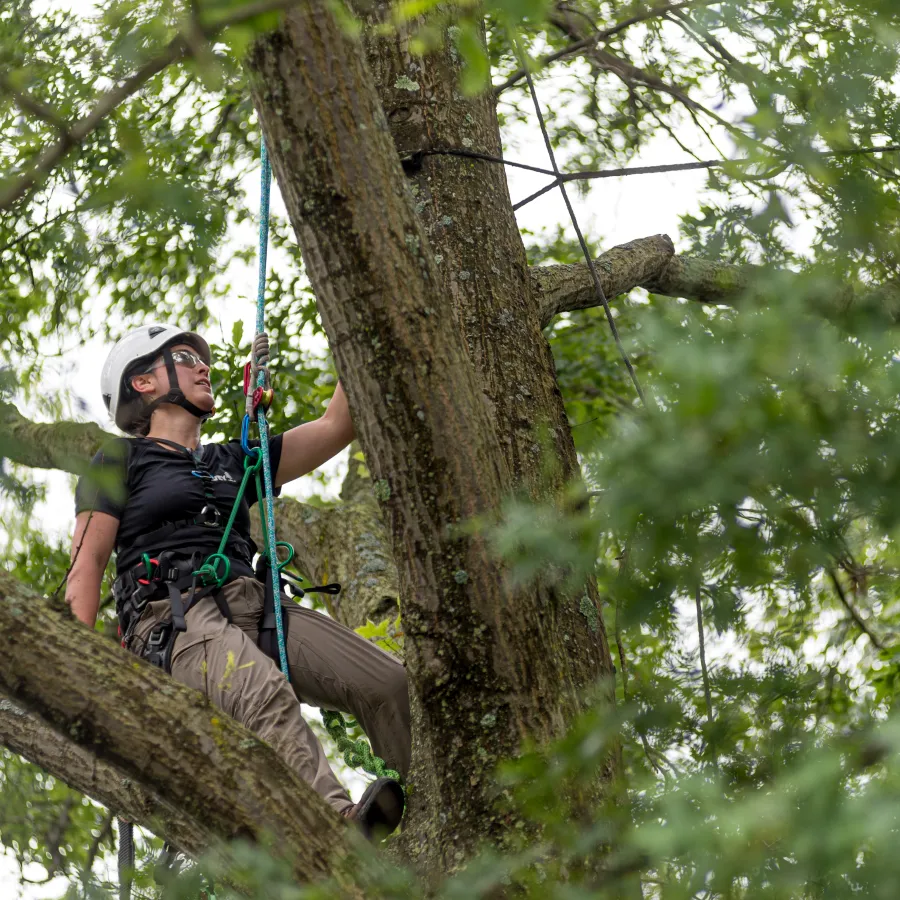Checking in with Botanic Garden Intern Alum Alex Julius ’09
Where Are They Now

Published March 22, 2024
From Tiger Doctor to Arboriculture: How One Smithie Found Her Way Up High in the Trees
Personal Essay by Alex Julius ’09
Like many before me, I arrived at Lyman Plant House rather unintentionally.
One of the many reasons I chose Smith College was its rock-climbing facility, because that seemed logical to 19-year-old me. As a first year, I set out as a chemistry major and took a work-study position at the rock wall. But before I finished my first semester I realized chemistry was not in my future. I switched gears and decided on an architecture major. Unfortunately (or fortunately), I was late selecting courses and couldn’t get into the architecture studio, so I ended up in a landscape architecture course. My adviser recommended that I enroll in a horticulture class taught at the botanic garden to accompany the course. That is how I found myself at Lyman—and how I ended up on the path to my current career.
Somewhere in the whirl of horticulture classes and a 2007 summer internship at the botanic garden, I found myself once again wandering into a new direction. Watching John Berryhill (who was chief arborist at that time and now serves as landscape curator) climbing trees, tying knots, pruning and using chainsaws, I knew that was where I wanted to be. But what was that even called? Arborist isn’t exactly a familiar term to most college advisers when they’re helping students plan their futures. With some behind-the-scenes wizardry facilitated by John and Gaby Immerman (experiential learning specialist and horticulture instructor), I was offered a work-study position in the arboretum and I learned how to climb trees—transferring my skills from rock climbing to tree climbing.
As a botanic garden intern, I was able to focus on developing my skills as an arborist. I took on the project of developing a five-year risk management plan for maintaining Smith’s roughly 1,200 accessioned trees. We were working from scratch, trying to develop a policy that would make the best use of Smith’s tree risk management resources. At this time, there were no other management plans we knew of to guide us.
After graduating from Smith, I continued my arboriculture education at University of Massachusetts Amherst. Brian Kane, the professor who served as my adviser, had helped me up my first tree at Smith three years prior. Though I’d wanted to continue my Smith risk management plan as my thesis project, Brian had another idea that would profoundly shape my career: making sure tree care companies were working safely. I spent six months, and 15,000 miles driving around, observing tree care companies to assess their compliance with the industry safety standard set forth by the American National Standards Institute, ANSI Z133. Tree care is one of the deadliest industries, and it is still generally unregulated. My research was intended to find out if credentialing correlated with higher safety compliance.
When I began applying to tree care jobs after graduate school, I had my master’s in arboriculture and was an International Society of Arboriculture (ISA) Certified Arborist. But I got few callbacks, and kept getting rejections. So I decided to remove any gender references on my resume, and I got the next job I applied for. Was that the reason I got the job or was it just a coincidence? I’ll never know. But coming from the place of privilege I had as a woman at Smith, it was eye-opening to find myself unemployed as I sought a job in a male-dominated industry.
Six years later, I started at the ISA to run a new program, the Tree Risk Assessment Qualification (TRAQ), prompted by the release of the industry’s new standard for tree risk management. I spent the next six years working on the program, including content updates, delivery enhancements, and instructor management. Today, the program serves as the leading credential for consulting arborists assessing trees for risk. This methodology became the backbone of Smith’s own tree care plan and arboriculture standards, and it has served as the blueprint for such plans at leading botanic gardens, cultural institutions and municipalities around the country.
Four years ago I joined The Davey Tree Expert Company, one of the world’s largest tree companies, as the employee development and safety training specialist. My main areas of focus are tree risk assessment, arborist credentialing and safety. I am also part of a team working on a company-wide initiative for JEDI (justice, equity, diversity and inclusion). In my free time, I work on the safety standard, teach at the Women’s Tree Climbing Workshop, and build bridges to neighboring industries such as landscapers and public gardens.
The tree care industry has changed since I embarked on this career. I’ve earned a graduate certificate in instructional design, which informs how I approach developing educational content. In 2021, I co-authored the Tree Climbers’ Guide (4th edition) with Sharon Lilly (who is known as the mother of arboriculture). The book covers the fundamentals of professional tree climbing, and serves as a study guide for those seeking to become ISA Certified Tree Worker Climber Specialists. In 2022, I was featured on the cover of the ISA publication Arborist News, depicting the changing face of arboriculture. That same year, in collaboration with other women in arboriculture, I presented at the American Public Gardens Association's national conference.
Arboriculture still has a long way to go when it comes to equity, but I see change happening. There are more women and people of color in positions of influence in the industry.
I couldn’t have anticipated that my career would have led me to where I am now, particularly since I thought I was going to become a tiger doctor. Arboriculture is a constantly evolving industry, as new technology, research and the voices of women allow us to expand what we can offer clients and colleagues.